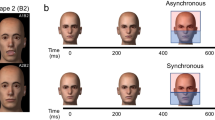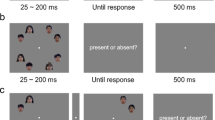Abstract
The enactive approach to perception describes experience as a temporally extended activity of skillful engagement with the environment. This paper pursues this view and focuses on prosopagnosia both for the light that the theory can throw on the phenomenon, and for the critical light the phenomenon can throw on the theory. I argue that the enactive theory is insufficient to characterize the unique nature of experience specific to prosopagnosic subjects. There is a distinct difference in the overall process of detection (with respect to eye movement sequence) of familiar and unfamiliar faces in prosopagnosia; in contrast, normal subjects use the same scanning strategy when exploring both kinds of faces despite an obvious difference in qualitative character. In light of this limitation I outline a supplemental view basing sensorimotor contingencies upon the establishment and reaffirmation of regularities within the organism as it engages with the environment.


Similar content being viewed by others
Notes
More on this later.
For a detailed description of these sensorimotor contingencies see O’Regan and Noë (2001).
It is important to note that by ‘non-veridical’ I simply mean that the experience itself is inconsistent with what we regard as true (i.e. the world ‘out there’ is not in fact moving). I do not use this term to suggest that one does not truly experience it as such.
The eyeball itself, in one’s normal course of visual exploration, does not take on such a shape, hence this alteration is severe with respect to experiential character.
Whose veridical basis, I will argue, stems from further exploration coinciding with the relevant laws abstracted.
I owe this analogy to Cecelia Burman’s (2004) website.
The difficulty largely stems from the fact that brain damage to such a specific area of tissue is relatively unrestricted (e.g. head trauma, tumors, etc.), particularly because systematic destruction of brain portions to determine function (the experimental ablation method) is not employed in humans – for obvious ethical reasons. See also: Farah (2004, p. 2).
In this case, simply looking at human faces.
Or, in the case of prosopagnosia, a lack thereof.
E.g. A familiar face perceived as unfamiliar.
It is important to note that there is nothing wrong with voluntary eye movement or the visual field. That is, this is a ‘blindness’ to faces only.
[H]igh lambda indexes the predictable control of scanpaths by external features in a visual stimulus, while low lambda indexes the scanpaths that are less directly predicted from the visual stimulus under consideration (Rizzo and Hurtig 1987, p. 43).
For example, a face seen as ‘Mom’ verses a face unidentified or seen as ‘unfamiliar’.
“...la vision est palpation par le regard” (Merleau-Ponty 1964, p. 177).
The statement is made in regards to adaptation to reversing goggles.
A more concrete example of this is the blindness experienced as one puts on inverted lenses for the first time. For a full interpretation of this see Hurley and Noë (2003).
By ‘confusion’ I simply mean that, sense cannot be made.
Typical autonomic responses can be measured by electrodermal discrimination in skin conductance response tests.
Such implicit responses are often given the role of emotion, and likewise this delusion is often characterized as ‘loss of’ or ‘under-active’ “emotional recognition system” (Carter 1999, p. 123).
Upside down faces are not within the purview of typical visual contingencies.
In an effort to explore lateralization biases in object exploration.
The delusional belief that different people are in fact the same person.
e.g. A person who, while looking at a picture of their own face does not recognize himself.
I owe this point to Dr. Gregory Zelinksy (personal communication).
References
Burman, C. (2004). http://www.prosopagnosia.com/main/stones/index.asp.
Carter, R. (1999). Mapping the mind. Berkeley: University of California Press.
Churchland, P. M. (1995). The engine of reason, the seat of the soul. Cambridge: The MIT Press.
Clark, A. (2002). Is seeing all it seems? action, reason and the grand illusion. Journal of Consciousness Studies, 9(5–6), 181–202.
Damasio, A. (1994). Descartes’ error: Emotion, reason, and the human brain. New York: Harper Collins.
Damasio, A. R. (1999). The feeling of what happens. San Diego: Harcort, Inc.
Damasio, A. R., & Tranel, D., et al. (1990). Face Agnosia and the Neural Substrates of Memory. Annual Reviews Neuroscience, 13, 89–109.
Farah, M. J. (2004). Visual agnosia second edition. Cambridge: The MIT Press.
Farah, M. J., & Wilson, K. D., et al. (1995). The inverted face effect in prosopagnosia: Evidence for mandatory face-Specific perceptual mechanisms. Vision Research, 35(14), 2089–2093.
Grill-Spector, K., & Knouf, N. et al. (2004). The fusiform face area subserves face perception, not generic withing-category identification. Nature Neuroscience, 7(5), 555–562.
Helmuth, L. (2001). Where the brain tells a face from a place. Science, 292(5515), 196–198.
Hurley, S., & Noë, A. (2003). Neural plasticity and consciousness. Biology and Philosophy, 18, 131–168.
Kanwisher, N., & Moscovitch, M. (2000). The cognitive neuroscience of face processing: An introduction. Cognitive Neuropsychology, 17, 1–11.
Kilgour, A. R., & Gelder, B. d., et al. (2004). Haptic face recognition and prosopagnosia. Neuropsychologia, 42, 707–712.
Leonards, U., & Scott-Samuel, N. E. (2005). Idiosyncratic initiation of saccadic face exploration in humans. Vision Research, 45, 2677–2684.
Levin, H. S., Eisenberg, A. L., et al. (Eds.) (1991). Frontal lobe function and dysfunction. New York: Oxford University Press.
Merleau-Ponty, M. (1964). Le Visible et l’Invisible, Gallimard.
Noë, A. (2004). Action in Perception. Cambridge: The MIT Press.
Noë, A. (2005). Real Presence. Copenhagen: World and Mind.
Norton, D., & Stark, L. (1971). Scanpaths in saccadic eye movements while viewing and recognizing patterns. Vision Research, 11, 929–942.
O’Regan, J. K., & Noë, A. (2001). A sensorimotor account of vision and visual consciousness. Behavioral and Brain Sciences, 24(5), 939–1031.
Rizzo, M., & Hurtig, R., et al. (1987). The role of scanpaths in facial recognition and learning. Annals of Neurology, 22(1), 41–45.
Rossion, B., Caldara, R., et al. (2003). A network of occipito-temporal face-sensitive areas besides the right middle fusiform gyrus is necessary for normal face processing. Brain, 126(11), 2381–2395.
Sergent, J., & Poncet, M. (1990). From covert to overt recognition of faces in a prosopagnosic patient. Brain, 113, 989–1004.
Thompson, E. (2005). Sensorimotor subjectivity and the enactive approach to experience. Phenomenology and the Cognitive Sciences, 4(4), 407–427.
Walker-Smith, G. J., & Gale, A. G., et al. (1977). Eye movement strategies involved in face perception. Perception, 6, 313–326.
Weber, R. B., & Daroff, R. B. (1971). The metrics of horizontal saccadic eye movement in normal humans. Vision Research, 11, 921–928.
Weber, R. B., & Daroff, R. B. (1972). Corrective movements following refixation saccades; type and control system analysis. Vision Research, 12, 467–475.
Young, A. W., & Haan, E. H. F. D. (1988). Boundaries of covert recognition in Prosopagnosia. Cognitive Neuropsychology, 5(3), 317–336.
Author information
Authors and Affiliations
Corresponding author
Rights and permissions
About this article
Cite this article
Kagan, A. Face to face with an enactive approach: A sensorimotor account of face detection and recognition. Phenom Cogn Sci 6, 509–525 (2007). https://doi.org/10.1007/s11097-007-9070-2
Published:
Issue Date:
DOI: https://doi.org/10.1007/s11097-007-9070-2




